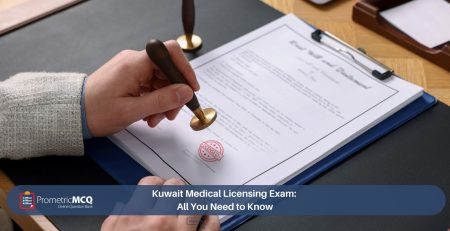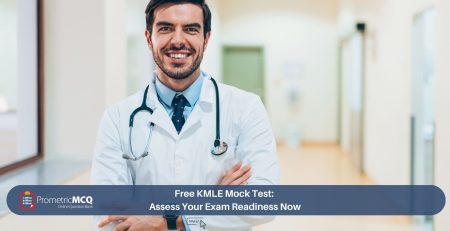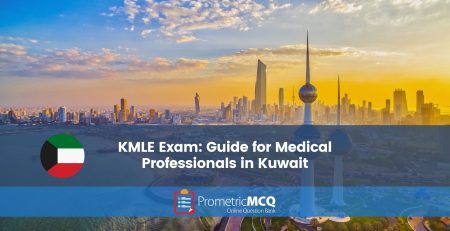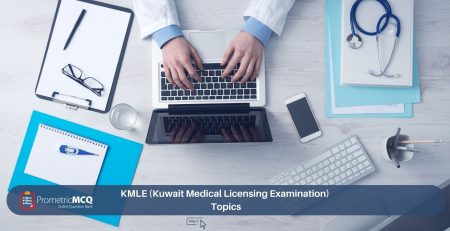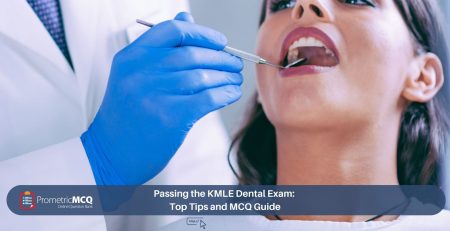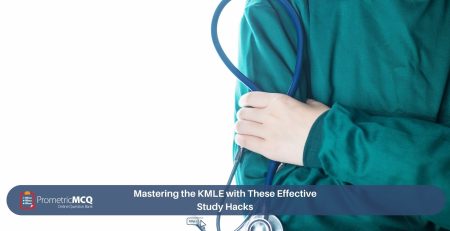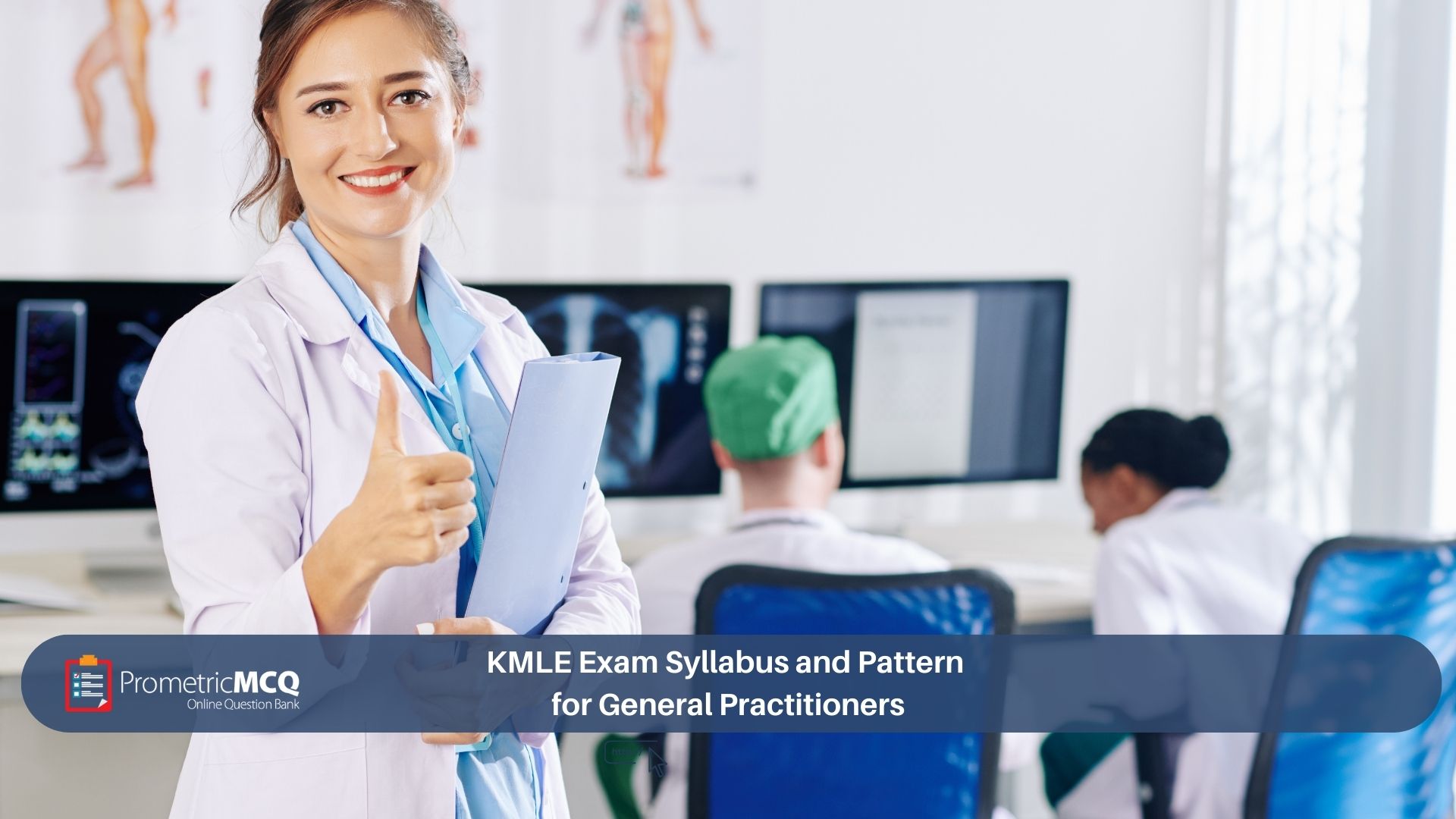
KMLE Exam Syllabus and Pattern for General Practitioners
fatima@prometricmcq.com2025-09-19T20:39:25+00:00Table of Contents
ToggleKMLE Exam Syllabus and Pattern for General Practitioners (2025)
Kuwait’s commitment to building a world-class healthcare system has made it a prime destination for General Practitioners (GPs) from around the world. The opportunity to work in a modern, well-equipped environment is a significant draw, but it comes with a rigorous vetting process. At the heart of this process is the Kuwait Medical Licensing Examination (KMLE) for General Practitioners. This is not just an academic test; it is a comprehensive assessment of a physician’s ability to practice medicine safely, effectively, and according to the highest international standards.
A deep understanding of the KMLE’s pattern and syllabus is the bedrock of a successful preparation campaign. The exam is specifically designed to evaluate clinical reasoning and decision-making skills through a series of case-based Multiple-Choice Questions (MCQs). Simply memorizing facts from textbooks is an inefficient and often ineffective strategy. Instead, candidates must learn to dissect clinical scenarios, formulate differential diagnoses, and choose the single best course of action—all within a strict time limit.
This ultimate 2025 guide will serve as your strategic blueprint for the KMLE GP exam. We will provide a meticulous breakdown of the exam pattern, a deep dive into the high-yield syllabus topics across all major medical disciplines, and realistic sample MCQs with detailed rationales to sharpen your analytical skills. This is complemented by a comprehensive 10-point FAQ section to answer all your logistical and strategic questions, ensuring you walk into the Prometric center with clarity and confidence.
Key Takeaways for the KMLE GP Exam
- It’s a Clinical Reasoning Exam: The KMLE tests your ability to think and act like a competent GP in a busy clinic or emergency setting.
- Internal Medicine is the Core: A vast majority of questions will come from Internal Medicine and its subspecialties. Master this domain above all others.
- Know Your Guidelines: Answers must align with the latest international, evidence-based clinical guidelines (e.g., for hypertension, diabetes, asthma).
- Master the “Next Best Step”: The most common question format requires you to choose the most appropriate next step in patient management, not just the final diagnosis.
- MCQ Practice is Essential: The only way to master the format and timing is to solve thousands of high-quality, case-based MCQs.
Deconstructing the 2025 KMLE Exam Pattern for GPs
Understanding the exam’s architecture is the first step toward creating an effective study plan. The KMLE for GPs follows a standardized international format, which is crucial for any medical professional to understand. This is a central theme in our general KMLE guide for medical professionals.
1. Test Administrator and Format
The KMLE is a Computer-Based Test (CBT) administered globally at secure Prometric test centers. The standard format for the GP exam is 150 MCQs to be completed in 3 hours (180 minutes). This gives you an average of 1 minute and 12 seconds per question, a pace that requires both deep knowledge and quick thinking.
2. Scoring and Outcome
The exam is graded as Pass/Fail, and the Ministry of Health does not provide a specific percentage. The unofficial passing threshold is widely considered to be around 60-65%. There is no negative marking, which means you must answer every question. An educated guess is always better than a blank space.
3. Question Style: The Clinical Vignette
Almost every question is a clinical scenario. You’ll be given a patient’s age, gender, presenting complaint, relevant history, physical exam findings, and sometimes lab or imaging results. Your task is to analyze this data and make a clinical decision. This requires a systematic approach to problem-solving.
The KMLE GP Syllabus: A High-Yield Domain-by-Domain Breakdown
While the syllabus is vast, reflecting the broad scope of general practice, certain areas are tested more heavily than others. A smart study plan allocates time proportionally to these high-yield domains.
| Core Medical Domain | High-Yield Topics and Key Concepts for 2025 |
|---|---|
| Internal Medicine (Approx. 50-60% of Exam) | This is the most important domain. Cardiology: HTN, ACS, Heart Failure. Endocrinology: Diabetes (Type 1 & 2), DKA/HHS, Thyroid disorders. Pulmonology: Asthma, COPD, Pneumonia. Gastroenterology: PUD, GERD, Viral Hepatitis. Nephrology: AKI, CKD basics. Rheumatology: RA, SLE, Gout. Hematology: Anemias. |
| Pediatrics (Approx. 15-20%) | Common infectious diseases (AOM, pharyngitis, croup, bronchiolitis), developmental milestones, vaccination schedules, management of dehydration, and febrile seizures. |
| Obstetrics & Gynecology (Approx. 10-15%) | Routine antenatal screening, management of common pregnancy complications (gestational diabetes, pre-eclampsia), diagnosis of abnormal uterine bleeding, PCOS, and common STIs. |
| General Surgery & Emergency Medicine (Approx. 10%) | Recognition and initial management of the acute abdomen (appendicitis, cholecystitis, pancreatitis), basics of trauma assessment (ATLS principles), and management of common emergencies like sepsis and anaphylaxis. |
| Psychiatry, Dermatology, ENT, Ophthalmology (Approx. 5-10%) | Diagnosis of common conditions a GP would encounter: Depression, Anxiety disorders. Acne, Eczema, common skin infections. Sinusitis, otitis externa. Red eye, conjunctivitis. |
A Strategic Guide to KMLE MCQs: Sample Questions & Rationales
Let’s apply this knowledge. The following sample questions are designed to mirror the clinical reasoning tested on the KMLE. The best way to improve is with a dedicated bank of General Practitioner MCQs.
Question 1: Internal Medicine (Endocrinology)
A 55-year-old woman with a known history of type 2 diabetes mellitus presents to the clinic for a routine follow-up. Her current medications are metformin 1000 mg twice daily and glipizide 10 mg daily. Her latest HbA1c is 8.5%. She has a history of a myocardial infarction 2 years ago. Which of the following would be the most appropriate addition to her regimen?
- Sitagliptin
- Pioglitazone
- Empagliflozin
- Basal insulin
Correct Answer: C (Empagliflozin)
Rationale: This question tests your knowledge of current diabetes guidelines. In a patient with type 2 diabetes and established atherosclerotic cardiovascular disease (ASCVD), such as a previous MI, the guidelines strongly recommend adding an agent with proven cardiovascular benefit. SGLT-2 inhibitors (like empagliflozin, canagliflozin) and GLP-1 receptor agonists (like liraglutide) have demonstrated a significant reduction in major adverse cardiovascular events (MACE). Empagliflozin is an excellent choice as it provides both glycemic control and cardiovascular protection.
Why other options are incorrect:
A: Sitagliptin (a DPP-4 inhibitor) is a reasonable option for glycemic control but has been shown to be cardiovascularly neutral, offering no additional benefit in a high-risk patient like this.
B: Pioglitazone (a TZD) is an effective glucose-lowering agent but is associated with a risk of fluid retention and can exacerbate heart failure, making it a poor choice in a patient with a history of MI.
D: While basal insulin would effectively lower her HbA1c, it does not provide the specific cardiovascular protection offered by an SGLT-2 inhibitor and is often reserved for when oral agents are insufficient or contraindicated.
Question 2: Pediatrics
A 4-year-old girl is brought to the emergency department by her parents with a 1-day history of high fever (40°C), sore throat, drooling, and difficulty breathing. She is sitting upright in a “tripod” position and appears anxious. On examination, her voice is muffled. What is the most important next step in management?
- Administer a dose of intramuscular ceftriaxone
- Attempt to visualize the pharynx with a tongue depressor
- Secure the airway in a controlled setting (operating room)
- Obtain a lateral neck X-ray
Correct Answer: C (Secure the airway in a controlled setting)
Rationale: This is a classic presentation of acute epiglottitis. The triad of drooling, dysphagia, and distress (the “3 Ds”), along with high fever and the tripod posture, is highly suggestive of this life-threatening condition. Epiglottitis causes severe inflammation and swelling of the epiglottis, which can lead to sudden and complete airway obstruction. Therefore, the absolute, number-one priority is to secure the patient’s airway. This should be done in a controlled environment like an operating room by an experienced anesthesiologist or ENT surgeon, with full resuscitation equipment ready.
Why other options are incorrect:
A: While antibiotics (like ceftriaxone for H. influenzae type b) are necessary, they are secondary to securing the airway.
B: This is extremely dangerous. Attempting to examine the pharynx with a tongue depressor can provoke laryngospasm and cause immediate, complete airway obstruction. It is absolutely contraindicated.
D: A lateral neck X-ray (which might show the “thumbprint sign”) can confirm the diagnosis, but it should not delay airway management in a patient in respiratory distress. The patient should not be sent to the radiology department if they are unstable.
Frequently Asked Questions (FAQs) for the KMLE GP Exam
The exam is graded as Pass/Fail. The Kuwait Ministry of Health does not release an official passing percentage. However, the accepted unofficial standard for passing is considered to be between 60% and 65%. To ensure a safe margin, you should aim to consistently score above 70% in your practice tests.
The GP exam tests the breadth of knowledge across all major medical fields, reflecting the scope of a primary care physician. A specialty exam (e.g., for an internal medicine specialist) tests the depth of knowledge in that one field, including more complex cases, rare diseases, and advanced management principles.
No, the KMLE clinical exam is based on international standards of medical practice and evidence-based medicine. You will not be tested on local public health policies, administrative structures, or specific epidemiology of Kuwait. Your study should focus on globally recognized guidelines, such as those from the World Health Organization (WHO) and other major international bodies.
No, the exam exclusively uses generic (international non-proprietary) names for all medications. You must be proficient with generic names (e.g., “metformin,” not “Glucophage”).
Once you pass the KMLE, you receive a result letter or certificate of eligibility from the Ministry of Health. This is typically valid for one year. You must find employment and complete the licensing process within this timeframe.
PSV is a mandatory background check of your credentials (degree, license, experience certificates) performed by a designated body. It is a separate process from the exam but is required by the Ministry of Health before they will issue your license. It’s wise to start this process alongside your exam preparation to avoid delays.
No, the KMLE for all medical professions is conducted only in English. A strong command of medical English is essential to understand the complex clinical vignettes.
While foundational knowledge from textbooks is important, the most effective strategy for the KMLE is active learning through a high-quality question bank (QBank). Solving thousands of case-based MCQs helps you master the content, understand the exam’s style, and perfect your time management. A dedicated QBank, like the KMLE Kuwait Prometric General Practitioner resource, is invaluable.
The Ministry of Health generally allows a candidate three attempts to pass the licensing exam. There is usually a mandatory waiting period between attempts. If you fail, it is critical to honestly assess your weak areas and significantly change your study approach, focusing more on question-based practice.
The final week is for review and simulation, not learning new topics. Consolidate your knowledge by reviewing your notes on high-yield subjects (e.g., ACS management, diabetes guidelines). Take one or two full-length timed mock exams to simulate the real experience. The day before the exam, do not study. Relax, eat well, and get a full night’s sleep to ensure you are mentally sharp.
Conclusion: Your Path to a Medical Career in Kuwait
The KMLE for General Practitioners is a comprehensive and challenging examination, but it is a fair and predictable one. It systematically evaluates the core competencies expected of a primary care physician in a modern healthcare system. By understanding its pattern, focusing your studies on the high-yield syllabus domains, and committing to a rigorous regimen of MCQ-based practice, you can transform this challenge into a tangible achievement. Success on the KMLE is the key that unlocks a professionally and personally rewarding medical career in Kuwait.
Ready to Master the KMLE and Secure Your License?
Our comprehensive question bank for General Practitioners is filled with realistic clinical cases, detailed, evidence-based rationales, and simulated exams designed to cover the entire KMLE syllabus and ensure you pass with confidence.


